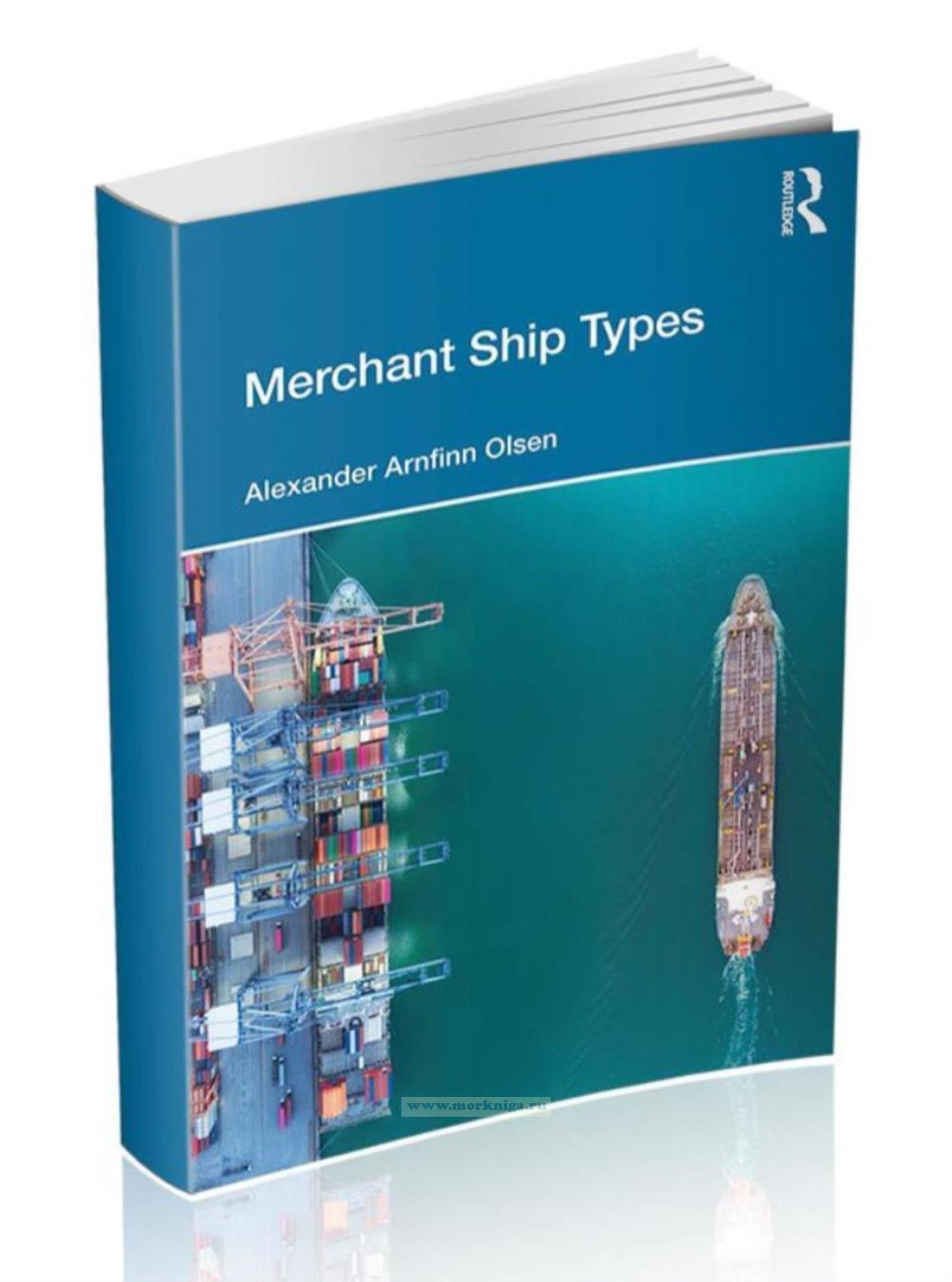Merchant Ship Types/Типы торговых судов
Книга на английском языке.
Merchant Ship Types provides a broad and detailed introduction to the classifications and main categories of merchant vessels for students and cadets.
It introduces the concept of ship classification by usage, cargo type, and size, and shows how the various size categories affect which ports and channels the types of vessels are permitted to enter. Detailed outlines of each major vessel category are provided, including:
- Feeder ship;
- General cargo vessels;
- Container ships;
- Tankers;
- Dry bulk carriers;
- Multi-purpose vessels;
- Reefer ships;
- Roll-on/roll-off vessels.
The book also explains where these are permitted to operate, the type of cargoes carried, and specific safety or risk factors associated with the vessel class, as well as their main characteristics. Relevant case studies are presented.
The textbook is ideal for merchant navy cadets at HNC, HND, and foundation degree level in both the deck and engineering branches, and serves as a general reference for insurance, law, logistics, offshore, and fisheries.
Contents
List of figures
List of tables
Preface
Acknowledgements
Abbreviations, glossary and terms used
Introduction
Ship classifications by size
Aframax
Baltimax
Capesize
Chinamax
Handysize
Handymax
Malaccamax
Panamax and New Panamax
Ship dimensions
Length
Beam (width)
Draught
Height
Cargo capacity
Records
Expansion of the Panama Canal locks
Post-Panamax and Post-Neo panamax ships
Qatar Flex (Q-Flex)
Qatar Max (Q-Max)
Seawaymax
Suezmax
Valemax
Very large and ultra large crude carriers
Ship classification by type
Naval vessels
Wet cargoes
Dry cargoes
Vehicle carriers
Passenger ships
Fishing vessels
Offshore oilfield vessels
Construction vessels
Harbour support boats
Specialist vessels
Ship classification by gears
PART I
Dry cargo ships
1 Bulk carriers
Development of the bulk carrier
Categories
Fleet characteristics
Flag states
Largest fleets
Ship builders
Freight charges
Ship breaking
Operations
Design and architecture
Machinery
Hatches
Hull
Safety
Stability problems
Structural problems
Crew safety
2 Container ships
Size categories
Container ship architecture
Cargo cranes
Cargo holds
Lashing systems
The bridge
Container fleet characteristics
Flag states
Vessel purchases
Scrapping
Largest container ships
Freight market
Container sector alliances
Container ports
Losses and safety issues
3 Feeder ships
Short-sea shipping
Short-sea shipping around the world
Europe
North America
Cabotage
Note
4 General cargo ships
Advantages and disadvantages
Note
5 Reefer ships
Development of the reefer ship
Refrigerated cargo systems
Refrigerated containers
Insulated containers
Environmental impact
Note
6 RORO vessels
Development of the RORO vessel
RORO stowage and securing of cargo
Safety aspects
Lack of subdivisional bulkheads
Maintaining stability
Vessel stiffness
The cargo doors
The stern door
The bow door
Location of lifeboats
7 Fishing vessels
Development of fishing boats
Commercial and industrial fishing vessels
Trawlers
Seiners
Line vessels
Other vessels
Notes
8 Research and scientific vessels
Categories of research vessel
Hydrographic survey
Oceanographic research
Autonomous research vessels
Technical research ships
Environmental Research Ships (AGER)
Weather ships
Tropical meteorology
Fisheries research
Naval research
Polar research
Oil exploration
Development of the research vessel
Race to the poles (19th century)
20th century
Between the world wars
The post-war period
Increasing collaboration
PART II
Wet cargo ships
9 Chemical tankers
10 FPSO and FLNG units
Development of the FPSO
FPSO records
11 Gas carriers
Types of gas carriers
Gas carrier codes
Gas carriers built after June 1986 (the IGC code)
Gas carriers built between 1976 and 1986 (the GC
code)
Gas carriers built before 1977 (the existing ship code)
Hazards and health effects
Toxicity
Hazards of ammonia
Flammability
Frostbite
Asphyxia
Spillage
12 LNG carriers
Cargo handling and cycle
Cargo containment
Moss tanks (spherical IMO type B LNG tanks)
IHI (prismatic IMO Type B LNG tanks)
TGZ Mark III
GT
CS
Re-liquefaction and boil off
13 Oil tankers and product carriers
Development of the oil tanker
Size categories
Tanker chartering
Fleet characteristics
Structural design and architecture
Cargo operations
Preparations for loading or unloading cargo
Loading cargo
Unloading cargo
Tank cleaning
Special use oil tankers
Floating storage and offloading units
Environmental impact and marine pollution
PART III
Passenger vessels
14 Cargo liners
The last cargo liner: RMS St. Helena (1989)
15 Cruise ships
Origins of the cruise ship
From luxury liners to megaship cruising
Cruise lines
Shipboard organisation
Crewing
Business model
Cruise ship naming
Cruise ship utilisation
Regional sectors
Shipyards
Safety and security
Piracy and terrorism
Crime on board
Overboard drownings
Stability
Health concerns
Norovirus
Legionnaires’ disease
Enterotoxigenic Escherichia coli
Coronavirus disease 2019 (COVID-19)
Environmental impact
16 Cruise ferry
Cruise ferry sectors
Eastern Baltic Sea
Silja Line
Viking Line
English Channel and Bay of Biscay
P&O
Brittany Ferries
Stena Line
North Sea
P&O
Stena Line
DFDS Seaways
Irish Sea
P&O
Stena Line
Scotland
NorthLink Ferries
Skagerrak
Color Line
Mediterranean
Grimaldi Lines
Moby Lines
Note
17 Ferries
Ferry types
Double-ended
Hydrofoil
Hovercraft
Catamaran
RORO ferries
Cruiseferry/ROPAX
Turntable ferry
Pontoon and cable ferries
Train ferry
Foot ferry
Docking
Sustainability
18 Ocean liners
Development of the ocean liner
Characteristics
Size and speed
Passenger cabins and amenities
Ship builders
Shipping companies
Routes
North Atlantic
South Atlantic
Mediterranean
Indian Ocean and the Far East
Other
Maritime disasters and incidents
PART IV
Construction and support vessels
19 Cable layers
20 Construction support vessels
Pipelaying ships
Heavy lift and crane vessels
Drillships
Dredgers
21 Icebreakers
Nuclear icebreakers
Function
Characteristics
Structural design
Power and propulsion
Polar class icebreakers
Polar class notations
Requirements
Polar Class ships
Polar Class 5 and below
Polar Class
Polar Class
Polar Class 2 and above
22 Offshore support vessels
Platform support vessels
Anchor handling tug supply vessels
Diving support vessels
Emergency tow vessels
National ETV fleets
Algeria
Finland
France
Germany
Iceland
Netherlands
Norway
Poland
South Africa
Spain
Sweden
Turkey
United Kingdom
Fireboats
23 Tugboats
Deep-sea or seagoing tugs
Harbour tugs
River tugs
Salvage tugs
Tenders
Propulsion systems
Kort nozzle
Cyclorotor
Carousel
PART V
Royal Fleet Auxiliary
24 Royal Fleet Auxiliary
RFA fleet
Index

